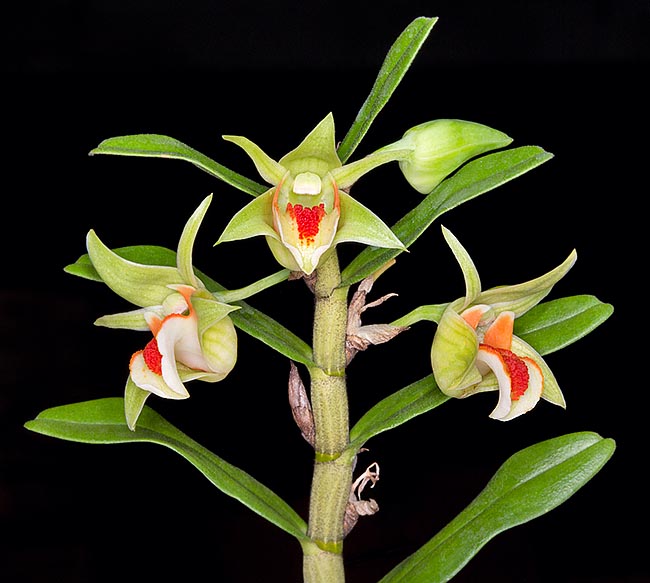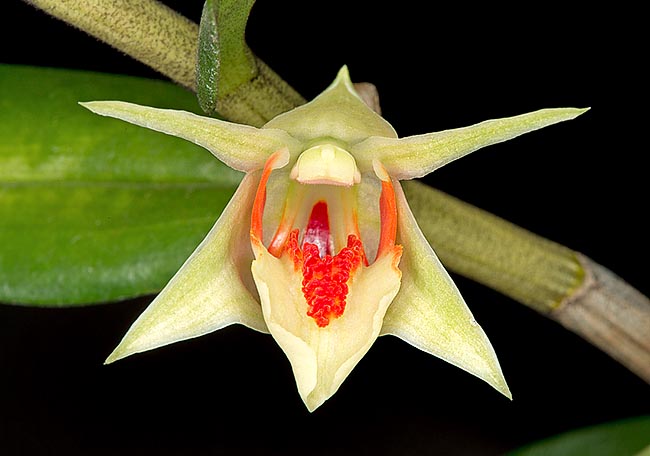Family : Orchidaceae

Text © Pietro Puccio

English translation by Mario Beltramini

Dendrobium cruentum is an epiphyte at home in Myanmar, Thailand and Vietnam © Giuseppe Mazza
The name of the genus is the combination of the Greek substantives “δένδρον” (Dendron) = tree and “βίος” (bios) life, the name of the species is the Latin adjective “cruentus, a, um” = bloody, blood-stained, with reference to the red spot on the labellum.
Common names: blood red dendrobium (English); ueang nok kaeo (Thai); hoàng thảo thanh hạc (Vietnamese).
The Dendrobium cruentum Rchb.f. (1884) is an epiphytic species with cylindrical erect pseudobulbs, slightly thinned at the apex and at the base, 15-35 cm long and of about 0,7 cm of diameter in the central part, provided for almost all their length of oblong-elliptic leaves, up to about 12 cm long and 2 cm broad, coriaceous, of glossy intense green colour; the foliar bases sheathing the pseudobulb are covered by a short black down.
Inflorescences at the nodes carrying 1-3 flowers, of 3,5-6 cm of diameter, with triangular sepals with pointed apex, 3 cm long and about 1 cm broad in the median part, of light green colour with darker venations, linear petals with pointed apex of the same colour as the sepals, about 2,5 cm long and 0,6 cm broad, and trilobed labellum, 2,5 cm long and 1,5 cm broad, consistent and of waxy look, with erect lateral lobes suffused of orange red and light green central lobe with coral red undulated margins and bright red spot at the base run by 5 crested lamellae.
It reproduces by seed, in vitro, micropropagation and division, to be done by the vegetative restart, with each section provided with at least 3-4 pseudobulbs.

Rare species, endangered, has 3,5-6 cm triangular flowers lasting about one month © Giuseppe Mazza
It requires a partial shade and medium-high temperatures in summer, 25-32 °C, averagely lower values in winter with night lowest not under the 15 °C, and high humidity, 70-80%, with a good and constant ventilation. The waterings must be regular and abundant during the vegetative period, from spring to autumn, but allowing to dry up before giving water again, then practically stopped in winter until the vegetative restart, with possible nebulisations so as not to wrinkle excessively the pseudo bulbs. For the waterings and nebulisations is to be used rain water, from reverse osmosis or demineralised; the fertilizations, duly distributed and alternated, in way to avoid salts accumulation to the roots, are to be done during the vegetative period preferably with balanced hydrosoluble products, with microelements, at ½ - ¼ of the dosage suggested on the package. It can be mounted on bark, trunks, rafts of cork or of arborescent ferns roots, or cultivated in little deep pots or baskets with much draining and aerated compost, to allow the roots to quickly dry up after each watering, which may be formed by medium sliced bark and charcoal fragments with possible addition of inerts to improve the drainage; transplants and repottings are to be done, when necessary, by the vegetative restart.
The species is reported in the appendix I of the CITES (endangered species for which the trade is allowed only in exceptional circumstances).
Synonyms: Callista cruenta (Rchb.f.) Kuntze (1891).
→ For general notions about ORCHIDACEAE please click here.
